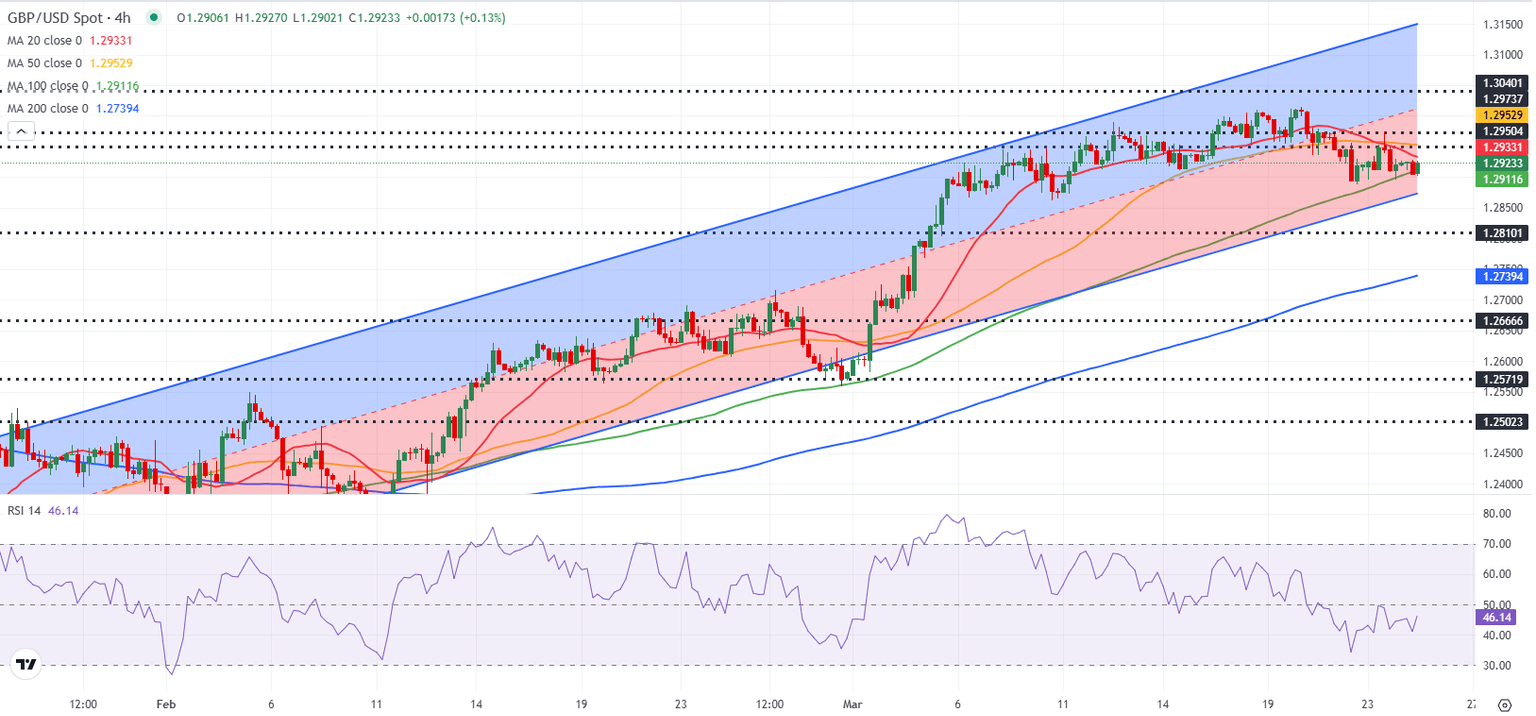GBP/USD Forecast: Sellers could take action if 1.2870 support fails
- GBP/USD trades in a tight range above 1.2900 in the European session.
- The pair could extend its slide if 1.2870 support fails.
- Markets await Consumer Confidence data from the US.

GBP/USD holds steady slightly above 1.2900 in the European session on Tuesday. The pair's technical outlook highlights that the bearish bias remains intact, albeit lacking momentum.
British Pound PRICE This week
The table below shows the percentage change of British Pound (GBP) against listed major currencies this week. British Pound was the weakest against the Canadian Dollar.
| USD | EUR | GBP | JPY | CAD | AUD | NZD | CHF | |
|---|---|---|---|---|---|---|---|---|
| USD | 0.16% | -0.04% | 0.78% | -0.27% | -0.40% | 0.13% | 0.07% | |
| EUR | -0.16% | -0.31% | 0.08% | -0.39% | -0.58% | 0.01% | -0.05% | |
| GBP | 0.04% | 0.31% | 0.82% | -0.70% | -0.30% | 0.33% | 0.15% | |
| JPY | -0.78% | -0.08% | -0.82% | -1.02% | -1.18% | -0.61% | -0.70% | |
| CAD | 0.27% | 0.39% | 0.70% | 1.02% | -0.09% | 0.40% | 0.33% | |
| AUD | 0.40% | 0.58% | 0.30% | 1.18% | 0.09% | 0.61% | 0.53% | |
| NZD | -0.13% | -0.01% | -0.33% | 0.61% | -0.40% | -0.61% | 0.00% | |
| CHF | -0.07% | 0.05% | -0.15% | 0.70% | -0.33% | -0.53% | -0.00% |
The heat map shows percentage changes of major currencies against each other. The base currency is picked from the left column, while the quote currency is picked from the top row. For example, if you pick the British Pound from the left column and move along the horizontal line to the US Dollar, the percentage change displayed in the box will represent GBP (base)/USD (quote).
GBP/USD started the week on a bullish note and climbed above 1.2970 before losing its traction in the American session, as the US Dollar (USD) benefited from the upbeat data. S&P Global Composite Purchasing Managers Index (PMI) rose to 53.5 in March's flash estimate from 51.6 in February, highlighting an ongoing expansion in the private sector's business activity at an accelerating pace.
In the second half of the day, the Conference Board will release the US Consumer Confidence Index data for March. A significant decline in this data could hurt the USD with the initial reaction and help GBP/USD keep its footing.
On Wednesday, the Chancellor of the Exchequer will deliver the UK 2025 Spring Statement in the House of Commons. Bank of England (BoE) Governor Andrew Bailey said on Monday that they face a challenge to raise the potential growth rate of the economy.
GBP/USD Technical Analysis

The Relative Strength Index (RSI) indicator on the 4-hour chart stays below 50, reflecting a lack of buyer interest. On the downside, 1.2870 (20-day Simple Moving Average (SMA), lower limit of the ascending regression channel) aligns as a key support level. If GBP/USD drops below this level and starts using it as resistance, 1.2800 (200-day SMA) could be seen as the next bearish target.
Looking north, first resistance could be spotted at 1.2960 (50-period SMA) ahead of 1.3000 (mid-point of the ascending channel, static level) and 1.3040 (static level).
Pound Sterling FAQs
The Pound Sterling (GBP) is the oldest currency in the world (886 AD) and the official currency of the United Kingdom. It is the fourth most traded unit for foreign exchange (FX) in the world, accounting for 12% of all transactions, averaging $630 billion a day, according to 2022 data. Its key trading pairs are GBP/USD, also known as ‘Cable’, which accounts for 11% of FX, GBP/JPY, or the ‘Dragon’ as it is known by traders (3%), and EUR/GBP (2%). The Pound Sterling is issued by the Bank of England (BoE).
The single most important factor influencing the value of the Pound Sterling is monetary policy decided by the Bank of England. The BoE bases its decisions on whether it has achieved its primary goal of “price stability” – a steady inflation rate of around 2%. Its primary tool for achieving this is the adjustment of interest rates. When inflation is too high, the BoE will try to rein it in by raising interest rates, making it more expensive for people and businesses to access credit. This is generally positive for GBP, as higher interest rates make the UK a more attractive place for global investors to park their money. When inflation falls too low it is a sign economic growth is slowing. In this scenario, the BoE will consider lowering interest rates to cheapen credit so businesses will borrow more to invest in growth-generating projects.
Data releases gauge the health of the economy and can impact the value of the Pound Sterling. Indicators such as GDP, Manufacturing and Services PMIs, and employment can all influence the direction of the GBP. A strong economy is good for Sterling. Not only does it attract more foreign investment but it may encourage the BoE to put up interest rates, which will directly strengthen GBP. Otherwise, if economic data is weak, the Pound Sterling is likely to fall.
Another significant data release for the Pound Sterling is the Trade Balance. This indicator measures the difference between what a country earns from its exports and what it spends on imports over a given period. If a country produces highly sought-after exports, its currency will benefit purely from the extra demand created from foreign buyers seeking to purchase these goods. Therefore, a positive net Trade Balance strengthens a currency and vice versa for a negative balance.
Premium
You have reached your limit of 3 free articles for this month.
Start your subscription and get access to all our original articles.
Author

Eren Sengezer
FXStreet
As an economist at heart, Eren Sengezer specializes in the assessment of the short-term and long-term impacts of macroeconomic data, central bank policies and political developments on financial assets.

















